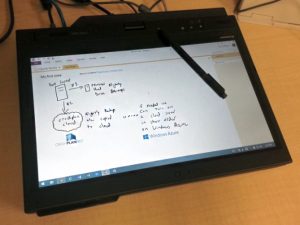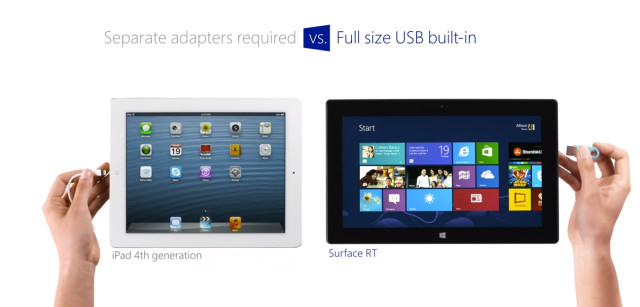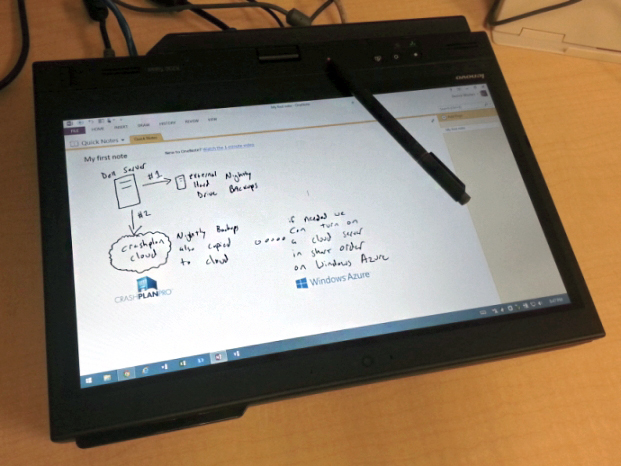Windows 8.1 + OneNote: Why the digital notebook is finally a reality
 In the mid-2000s, walking into a college classroom holding a laptop that came with a stylus for the purpose of note-taking was without a doubt out of place. The smartphone craze was still years away, and for all intents and purposes, touchscreens were relegated to two platforms: the Nintendo DS, and the last hurrah of Palm devices like the Treo. So when I sat in my undergrad classes taking notes in OneNote 2003 on my Thinkpad X41, people looked at me like I was an alien. Professors even asked from time to time whether I brought my paper notebook to class, so I wasn't playing with my "toy" the whole time.
In the mid-2000s, walking into a college classroom holding a laptop that came with a stylus for the purpose of note-taking was without a doubt out of place. The smartphone craze was still years away, and for all intents and purposes, touchscreens were relegated to two platforms: the Nintendo DS, and the last hurrah of Palm devices like the Treo. So when I sat in my undergrad classes taking notes in OneNote 2003 on my Thinkpad X41, people looked at me like I was an alien. Professors even asked from time to time whether I brought my paper notebook to class, so I wasn't playing with my "toy" the whole time.
Tablet PCs had a real personality dilemma way back then. Aside from OneNote, they were a sort of a pariah in the PC industry. Cool, sleek, powerful, and usually fairly light -- but they were held back in one major way: the operating system. I bless Microsoft for taking chances in areas where no one else dared, which undoubtedly led us to the current revolution being driven by Windows 8.1, but the first wave of Tablet PCs had real potential. The hardware was there, but the operating system was the large bottleneck by far.
Seeing how OneNote is hitting its 10th anniversary right about now, I wanted to take a moment to reflect on how useful the tool has been in my personal and professional life. In fact, I don't think any other app in the Office suite has come so close to fulfilling the long dream by users like myself to ditch the paper notebook once and for all.
In version 2003, they were merely proving a concept. 10 years later, come version 2013 and Windows 8.1, I think OneNote shifts the entire debate about how useful touch input can be, and why new age touch devices can allow us to rethink about where computers fit into our daily lives.
I never shied away from giving others impromptu demos of what my Thinkpad could do. Besides, the laptop landscape at the time was fairly drowned in uniformity. You had the usual flock of PC users, with a scattering of white Macbooks here and there by the trendsetters. But aside from one other student I vividly remember using a Fujitsu Lifebook (a computing school student, no less) there was no such thing as market penetration for Tablet PCs on campus. "Eww, what's that?" was more commonly the response from fellow students.
But again, the problem wasn't the form factor itself. Five or so years after I ended my first foray into tablet PC computing, I've come full circle back to another beloved Thinkpad, the X230 Tablet, and I've fallen (back) in love with not only the device itself, but this time, the operating system providing the UX as well. OneNote 2013 is indeed the killer touchscreen app for any tablet PC user (with stylus capability) and Windows 8.1 fills in the rest of the gaps.
Windows XP Tablet PC Edition Sucked, Yet OneNote Rocked -- What Gives?
I swear if it wasn't for that god forsaken awful excuse for a tablet operating system, XP Tablet PC Edition, Microsoft could have gotten the credit it deserved in getting the public thinking seriously about touch. Five years before anyone even contemplated Apple releasing a tablet, and a couple of years before the iPhone started the smartphone craze, Microsoft already had the seeds planted for what the next generation of computing could look like.
No doubt, it took us over seven years and no less than three major revisions of Windows to get there, but in many respects, Windows 8.1 and to some extent, OneNote 2013, are the culminating aspects of that vision Microsoft set out to achieve in the mid-2000s. As I said, the hardware wasn't the problem. My Thinkpad X41 Tablet of circa 2005 had excellent battery life of 4-4.5 hours; the touchscreen and stylus worked admirably for its time; and the form factor was just as good as what's on the market today (for convertible tablets - not pure slates, which are apples and oranges comparisons). Windows itself was the anchor holding the boat at bay.

Tablet PCs are nothing new. Steve Ballmer helped introduce the Thinkpad X41 Tablet (above) back in 2005, the same device I used throughout much of my undergrad studies at DePaul University. While OneNote 2003 was a fantastic tool that held its own weight, the hardware was clearly way ahead of its time in contrast to the software (namely, the cruddy Windows XP Tablet PC Edition). Windows 8.1 finally brings us the missing piece of this two-pronged functionality puzzle. (Image Source: CNET)
Perhaps Microsoft was trying to fill a void that was just way too ahead of its time. OneNote 2003 was truly a hidden gem of the Office suite back then. Most people hadn't heard of it, let alone tried it. Those who dabbled in it usually couldn't leverage it for what it was worth, because, as someone told me back in the day: why don't I just use Word? They didn't get it, but I couldn't blame them. Without a proper device and OS to put OneNote in its full glory, the application was shunned to the corner of the room when it came to mindshare.
Windows Vista came out in late 2006, and it too attempted to pick up where XP Tablet PC Edition left off, but it didn't fare much better. While it solved the problem of integrating the touch capability into the OS (instead of relying on layered-on drivers as was the case with the dreaded XP Tablet PC Edition), and making the user interface slightly more touch capable, the OS ruined other aspects of Windows that we came to love. Battery life (pre-SP2) was horrid, and application and driver compatibility were nightmarish at best (again, pre-SP2). So it was still a lose-lose situation for those like me who wanted to dive into a digital post-paper realm.
Windows 7 upped the ante further, by giving us excellent battery life and performance levels on lower end hardware that was never before seen, but the touch experience was still not fully leveraged. 7 was still at heart a desktop-only OS, with touch as a slight afterthought. OneNote was on a ship of its own, maturing through version 2007 and 2010, and landing finally on version 2013 -- resembling a product that truly deserves every ounce of its ten years of maturity.
It wasn't until Windows 8 launched that everything just clicked. Finally, an OS that provides the UX necessary to do OneNote and other touch-enabled power apps justice. Not only that, but the current generation of emerging Windows devices are proving to fill both the personal and work gaps for today's users. While Apple continues to push a notion that multiple devices are needed to fulfil a digital lifestyle nirvana -- a Macbook for work, an iPad at home as they prefer it -- Microsoft has eschewed towards a 'one device for all purposes' future.

What value proposition does the iPad bring to the table against Windows 8.1 devices aside from app selection? iWork? "The Apple Experience?" As I've said before, anyone can build a great consumption driven tablet. But giving users something they can leverage to fulfil a paperless lifestyle? The iPad doesn't come close to the Surface here.
If you think about it, much of it makes sense. How many people have upwards of $2000 to spend on a combination of laptop and tablet (going the Apple route, specifically)? Outside of the USA, this is far from feasible for the average person. Instead, Microsoft is slowly proving that a single device like a Surface can kick just as much rear end at the office as it can at home on the couch. Even at the $900 price point of the Surface Pro 2, that's still half of what it costs to equip oneself with a combo of Apple devices to fill the same needs. And in my eyes, you aren't sacrificing functionality in any way, either, unless a million count app store is your primary deciding factor. And even the disparity here is drifting away as the Windows Store now has over half of the most popular iOS apps on its ecosystem already, and that figure was from over two months ago.
If you are still curious at what Microsoft is trying to get at with the unified Modern UI across its ecosystem, you're clearly not seeing the writing on the wall. Next generation computing is just as much about touch as it is extending the traditional capability of Windows apps as we know them, and the Windows platform is here to solve all those needs without increasing the number of devices in your bag. That's true technical evolution in the purest sense.
Evernote is Great, But OneNote is Still King
A lot of people like to compare OneNote to the obvious not-so-distant cousin, which is Evernote. They are both billed as note taking apps. Each of them has similar ways in dividing content into areas and sections. And both of them have searching capabilities, import/export tools, and extra bells and whistles aimed at replacing our pen pads for good.
The big difference? One actually accomplishes that vision of replacing a paper notebook, and the other simply provides a very clean and organized way of collecting content and organizing it. For those that don't have access to a true tablet device with stylus input, either app will work just as well for your needs. But when it comes to true digital handwritten note taking, OneNote sweeps Evernote away in some major ways.
It's not like Evernote doesn't have hand writing support for inking. And it also claims to have OCR. But both of these functions seem like afterthoughts, at least from my experiences. Even on version 5.0.3, which is the latest release for Windows as of October 28, 2013, the program couldn't recognize my simple iteration of the written word "welcome" even after re-writing it about 4-5 times. Evernote's OCR process is server-side and free users get pushed to the back of the line. If I need to pay $45/year to become a premium Evernote user, it doesn't seem like that great of a value to me.
Why do I say that? Pound for pound, Evernote premium really doesn't provide much in terms of "must have" value compared to its free offering. Sure, I could shell out the $45/year and pick up a few novel features, but I think it's only fair to pit Evernote against that of what Office 365 Home Premium provides since that is what most average consumers would purchase to get access to OneNote 2013. In the interest of fairness, here is a little comparison chart I made to pit the two sides apples to apples:

As the above comparison chart shows, OneNote 2013 (as a part of Office 365 HP) is a stellar deal for what it provides. At $45/year, it's tough to justify the few benefits that Evernote Premium brings to the table, even if it is less than half the cost of Office 365 Home Premium. Getting 27GB of cloud storage, Office on Demand, and full desktop Office rights for up to 5 computers is tremendous value that easily trounces what Evernote is offering here. Mind you, none of the areas where Evernote trumps OneNote (namely in device support) are aspects of the paid Premium subscription.
While Evernote Premium admittedly has a more solid showing across a broader array of devices, the benefits end there. Office 365 Home Premium not only gives us access to OneNote, but the rest of the Professional equivalent of the suite for up to 5 computers (Mac or PC) which is on its own a stellar deal compared to face retail value for Office 2013 Pro. And when you don't have access to your desktop apps, you can launch the formidable Office Web Apps from SkyDrive, or opt to use the full blown "cloud streamed" equivalents via Office on Demand.
If you have your doubts about Office on Demand, have a look at the live demo I did at my Office 2013 class this past summer (it's towards the end of the video at about 1 hr 37 mins). It works, and it works darn well. Nothing about my live demo was canned in any way, so you may be just as surprised with how awesome Office on Demand really is.
Storage space is also much more plentiful on OneNote's side. Not only are your max note limits 10x higher at 1GB per notebook, but Microsoft's 27GB of space provided on the SkyDrive platform is also generous. This aspect can get a little thorny because yes, Evernote's cap is a monthly quota on uploads and Microsoft is capping your account by space used, not bandwidth, but by the time you reach 27GB you can easily purchase cheap upgrade space -- and that's if Microsoft hasn't raised its cap at that point.
And don't forget that Evernote's cloud storage is respectfully only for its own notes. SkyDrive is a regular bona-fide personal cloud storage space which you can use to not only store OneNote notebooks, but photos, music files, Word documents, etc etc. I just switched my own personal storage needs over to SkyDrive full time and happen to enjoy the service quite a lot. If you want to go the freebie route, you can get 7GB of space at no cost just by getting yourself a free Microsoft account.
The built in OCR capabilities of OneNote 2013 are also far beyond that of what Evernote is providing. Premium users get pushed to the "front of the line" when it comes to getting their notes OCR'd, and that's because their service relies on cloud rendering of anything that needs conversion. Free users get relegated behind that of Premium users, and in my testing, that's pretty accurate. Of the few simple tests I did on getting my handwriting searchable within the Windows desktop Evernote app, it failed on every attempt.
Seeing as Microsoft has been building on OneNote's OCR capabilities since 2003, they definitely have a maturity gap in their favor here. And since Microsoft's product doesn't rely on doing OCR in the cloud, this means you have the same level of searching access across your notebooks on a plane with no WiFi as you do at your home office with internet. This is a big benefit for travelers who rely on local notetaking access away from consistent internet connections on the road.

One of my favorite features about OneNote 2013 is how darn accurate it is in instantly searching my handwritten notes. It's not perfect -- my written hand is pretty sloppy, I admit. But as the photo above proves, OneNote had no issues tracking down the word I was searching for ("variable") in a multi-section notebook I am building in my latest grad school class. Evernote has to handle its OCR in the cloud, which when it works, is a slow experience for free edition users. None of my OCR tests with inking on Evernote were successful.
And it's also the extra fine touches that OneNote provides which push it over the top for me. For example, I can record audio (or video) right from within OneNote 2013 and have it embedded directly into my notebook page seamlessly. As a student in grad school, this is a great way to take snippets (or full recordings, if you wish) of class lectures and have them tucked contextually into my notes for that class. The files can even be played back right within OneNote; there's no need to manage separate media files in a clumsy manner. These functions aren't just feature fluff -- they work as advertised and do come in handy.
Some other interesting aspects are also readily apparent once you dig in. Math students should give the "Ink to Math" capability a try, as you can naturally write out tough equations that are otherwise a downright bear to get into text form without the help of paid addons to Word like the famous MathType which is nearly $60 for students on its own (more than half of the cost of Office 365 Home Premium alone). You can insert Visio and Excel documents natively into your notebook pages too, for quick markup capability without having to export your source files first.
Not to mention that you can screen clip anything on your computer screen and push it into your notebook for direct markup. In my above photo, you can see screen clips of PowerPoint slides that my grad school professor gives us access to before classes. So as we are following along in class, as other students are frantically trying to copy things into paper notebooks from her presentation and whiteboard notes, I'm merely clipping copies of slides into my OneNote page and bringing in her whiteboard notes with my own inking. I spend less time transcribing and more time adding important context to my class notes, making studying for exams much easier than my experiences using a paper notebook.

OneNote isn't just great for traditional note taking. It's also a fantastic drawing, mindmapping, and visual brainstorming tool. A perfect example is the above diagram I drew out for a client who asked me to describe a backup plan for an office server overhaul we are doing. Instead of spending 30+ mins in Visio, or writing a novel over email, I had a simple hand drawn diagram emailed out in 5 minutes.
This is not to say I don't use paper in any way. It may be a little while before I can fully ditch my beloved yellow flip notebook for day to day customer notes; it's almost a security blanket for me. But that's merely due to it being representative of my old guard, what I am merely "used to" in the way I work. Those processes can all change. And my move to a reliance on OneNote will slowly pull that crutch away until I no longer need the feel of a pen and paper for those instant moments of information gathering.
It's funny that it took me half a decade to come full circle and try the same technology again which I grew so accustomed to back in college. But in many ways, it is an entirely new experience. Windows XP Tablet PC Edition was a sad, sad excuse for a tablet operating system. It did the hardware no justice in providing a clean and seamless user experience. I fought against the tide because OneNote 2003 itself was a wonderful program for what it provided. Windows 8.1 finally brings together the OS and mends the program to the hardware in a way that was ever so lacking.
I've played with more than enough iPads during my time working in the public education system. I actually happen to own a Nexus 10 Android tablet (which is not half bad, at consumption, but it gets little regular usage). But for my day to day work consulting needs, and getting through grad school, Windows 8.1 with OneNote on my Thinkpad X230 Tablet is a combination of hardware/software that does everything I want. Personal and work related alike.
I don't ascribe to the Apple notion that you need 2 distinct devices to be satisfied. One is suiting me quite well, and I don't yet have any regrets about the move I made. As more working professionals start pulling back at the FUD companies like Apple love to sow, they may finally "get it" like I did.
NOTE: A lot of colleagues ask me why on earth I didn't just move to a Surface Pro or Surface Pro 2. It came down to a lack of docking options months back (which has recently changed) and the necessity to have access to a wired network port on my primary device. I'm an IT consultant by day which means I'm knee deep configuring and troubleshooting infrastructure equipment in the field for clients often. For that reason alone the Surface Pro 2 could not suit my day to day needs without carrying multiple devices. Hint to Microsoft on what the Surface Pro 3 should have?
 Derrick Wlodarz is an IT Specialist who owns Park Ridge, IL (USA) based technology consulting & service company FireLogic, with over eight+ years of IT experience in the private and public sectors. He holds numerous technical credentials from Microsoft, Google, and CompTIA and specializes in consulting customers on growing hot technologies such as Office 365, Google Apps, cloud-hosted VoIP, among others. Derrick is an active member of CompTIA's Subject Matter Expert Technical Advisory Council that shapes the future of CompTIA exams across the world. You can reach him at derrick at wlodarz dot net.
Derrick Wlodarz is an IT Specialist who owns Park Ridge, IL (USA) based technology consulting & service company FireLogic, with over eight+ years of IT experience in the private and public sectors. He holds numerous technical credentials from Microsoft, Google, and CompTIA and specializes in consulting customers on growing hot technologies such as Office 365, Google Apps, cloud-hosted VoIP, among others. Derrick is an active member of CompTIA's Subject Matter Expert Technical Advisory Council that shapes the future of CompTIA exams across the world. You can reach him at derrick at wlodarz dot net.